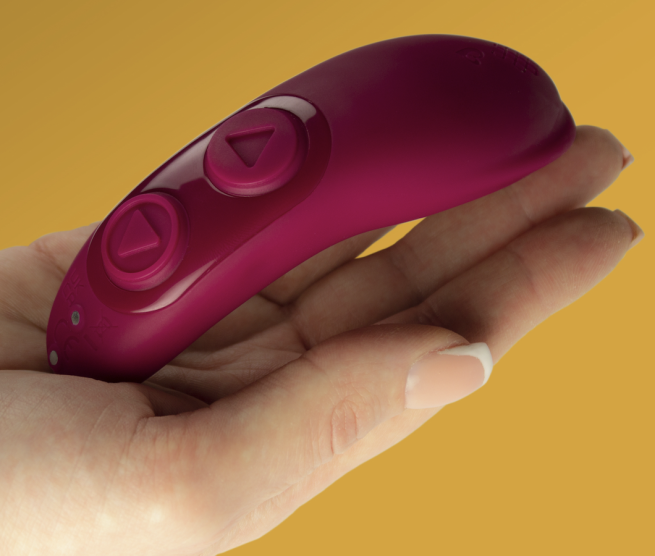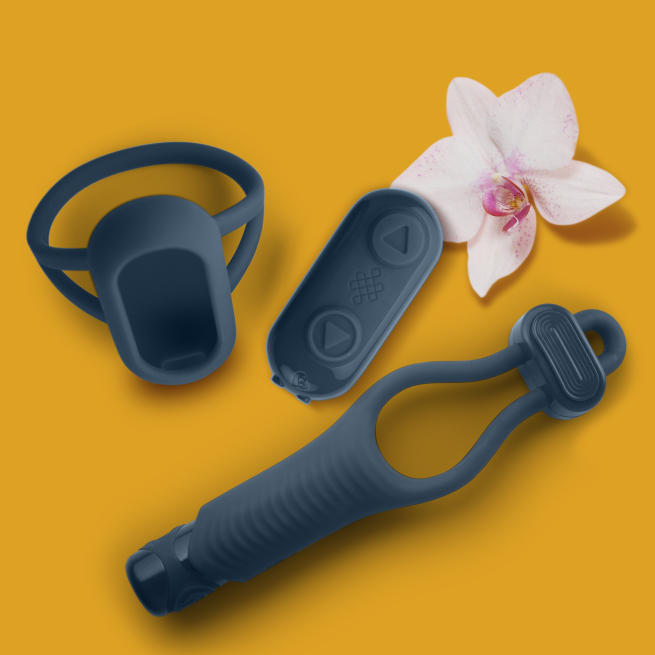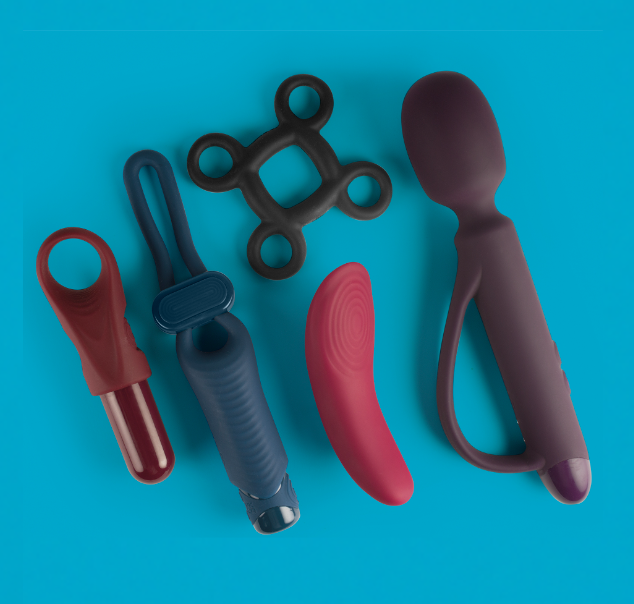
We know how difficult it can be to recommend a sex toy to someone.
Everyone has different needs and ideas of what toys they would like to try. However, we find that when it comes to recommending sex toys to disabled or neurodivergent customers, often sex shop sales assistants are not trained in what might work.
Why do we need accessible products anyway?
We all do!
Lots of people don’t think twice about sending a text message to their friends, but don’t realise that texting was invented for deaf people. This is a great example of accessible things that can benefit everyone. It’s the same with sex toys – small design tweaks can make a big difference.
Shopping can often be difficult for disabled and neurodivergent people. Physical sex shops are often in small buildings with steps, and the staff are not trained. This can and often does mean disabled people are excluded from buying toys in person and resort to online shopping.
This resource will help you understand how to see products differently, through accessible design, changes that can be made to existing products, and training staff. It will also examine how a physical sex shop can be changed to be more inclusive.
Accessible sex toys and accessories
There are so many accessible features that sex toys can have that could make a difference. It’s impossible to name every toy available, so here are some of the adaptations that you need to keep an eye out for:
Wrist and finger loops and handles
Playtime shouldn’t be held back by mobility. Adding finger or wrist straps to toys can help people keep hold of them if wrist flexibility and grip are difficult. This includes any of the accessories that come with certain toys, such as remote controls. Adding handles to larger toys, such as wands, makes them easier to grip and control.
Shop the Quest range: Discover Wand page
Easy instructions
Some neurodivergent people may struggle with reading complex information by not being able to focus, skipping ahead, or having conditions such as dyslexia affecting the way they read.
Keep the information simple and to the point – avoid acronyms or slang. Could you potentially present the information differently? Some people prefer to access information through videos or audio. This isn’t just helpful for neurodivergent people but for visually impaired people, too.
It’s worth remembering to look at captions on any videos you use so that they can be accessible to D/deaf people. Is it possible to present instructions or information through a British Sign Language (BSL) interpreter?
If you can, could you offer to show the customer how to switch the toy on and how to change the vibrations? If you do have a customer who struggles with complex instructions, aim to recommend a toy that is more easily controlled, such as bullet vibrators that switch on and off more easily. If they can start there, then they can add more complexity when they invest in their next toy, increasing the difficulty as they go.
Large buttons
Larger buttons can be a godsend for everyone!
However, they are particularly great for anyone who is visually impaired, as they are easier to see and press. Adding LED lighting to the buttons can also help people recognise where they are or if a toy is charging or not. Larger buttons can also be useful for people with poor dexterity.
Keep the choices of buttons as simple as possible. Too many options can be confusing for people. If you do have multiple button choices, make it clear in the instructions as to how to use them. This includes how to pair an app, which can be tricky.

Music
Some of the newer, fancier sex toys can be paired with apps that use music accounts like Apple or Spotify. Music can help neurodivergent people with their experience by encouraging relaxation, which can help with orgasm. It can help to minimise noisy distractions, which can cause a problem.
Fiddly bits!
Small attachments and chargers can be a nightmare as they are difficult to use if you have poor dexterity or grip. Look for toys that are easy to attach, have snap charging, or the attachments can be removed with one hand.
Different textures
Neurodivergent people can struggle with certain textures, but it is different for everyone. Some may not like textured vibrators, condoms or scented lubricants. This is a conversation to have with the person as to what they prefer and what toy might work.
Some neurodivergent people like a firmer toy which may mean recommending a harder material bullet or wand. Others may prefer a light touch so a clitorial suction simulator toy would work better.
Quiet vibes
A lot of people worry about their vibrators being heard by roommates! It’s also worth noting that this includes D/deaf people who cannot hear if their products are noisy or not. Avoid adding the word quiet or silent if your toy really isn’t, or recommending one that you haven’t heard in action. A quiet vibrator should be around 55 db, but be aware that bullets can be louder at around 75 db

Sex position wedges
These are cushions that support the body in pleasurable positions for long times. They can be equipped with strong loops usually used for attaching restraints. They are wedge-shaped which aims to lift a person’s pelvis, placing them into position.
Easy-to-open packaging
There is no point in having an accessible toy if someone can’t open the packaging. If you are working in a sex shop, it’s worth knowing what toys can be easily opened using teeth, one-handed or those that don’t need a lot of force to open.
The information
If possible, could you provide information in braille on the box or British Sign Language videos? This can help to break down what people need to know to make it accessible for them. You can place QR codes on the boxes to direct people to videos.
Strap ons
Not all strap-ons are created equal! Some disabilities or health conditions, such as spinal injuries, erectile dysfunction or mobility impairments, can make penetration difficult. It can be helpful to try strap-on harnesses or underwear equipped with compatible sex toys.
There are different styles from underwear to harnesses so it’s worth a conversation with your customers about what might work for them. Some may prefer underwear styles for ease of use or others may find adjustable harnesses better. Once a harness is fitted into a shape, it very rarely needs to be adjusted.
Just a note on dildos – be mindful that many queer people may not want dildos that are shaped or painted to look like realistic penises. There are lots of companies that are queer-owned and sell alternative shapes or coloured attachments for this reason. Again, it’s personal preference but don’t assume that someone will want something realistic.
Bondage tape
A cheaper alternative to expensive harnesses or wedges. It can be used to strap sex toys to pillows, body parts, wheelchairs or beds to hold them in place.
Lubricant
Adding a little lube can go a long way. There are lots of different health conditions that can cause vaginal dryness so it’s worth talking to your customer about if they need or want any lubricant. This is where you will need to talk about what they want and what they are using it for.
For example, recommending an oil-based lubricant for someone using it with silicone toys or condoms is going to be dangerous. Alternatively, some neurodivergent people may struggle with heavily scented products or those with stickier textures.
Quest
Did you know we have an accessible toy range designed by leading toy experts, Rocks Off?
There are six toys in the range including adjustable cock rings, bullet vibrators and vibrating wands. The range was created by disabled people with accessibility in mind, from shopping to shipping to use. Every part of the user journey has been designed to make it as accessible as possible.
View The Quest Range by visiting the Rocks Off Quest Shop

Physical shops
Queues:
Queues can be difficult to manage especially at busy periods such as sales, Christmas or the lunchtime rush. Queues can also be difficult for neurodivergent people who struggle with busy areas. Viligant staff may be able to work with disabled customers to help them avoid the queues or crowds by asking someone using a wheelchair to wait somewhere quiet and call them when ready?.
Heavy bags:
Don’t assume that someone will be able to lift a heavy shopping bag – ask. If you can, pop around the counter to hand it to someone or ask what they would like you to do with the bag. It would be great to offer help with packing the bags if someone has a coordination impairment or poor dexterity.
Counter height
People need to be able to pay! Often counter height can be set far too high for someone who is using a wheelchair. You could use different options such as different height counters throughout the shop. Alternatively, allow customers the option to pay where they are instead of having to go to the counter.
Wire-free card machines
Card machines are increasingly becoming wireless so that they can be transported to the person. If your card machine has a wire, you must check that it is long enough for a wheelchair user to access.
Move items on the floors:
Move any objects or clutter on the floor that shouldn’t be in the way, taking care to tuck in leads or plugs that may cause problems for visually impaired people. This includes moving items off the floor – especially during busy sale periods!
This also goes for A-signs which are often popped on a floor when there is a wet floor or other hazards. It may be difficult to manoeuvre around them, especially in smaller shops where there are narrow aisles. They must be removed again when the floor is dry to avoid accidents or make access easier.
Venue audits and planning
Doing a venue audit before you open a new retail space is a great idea. You should examine your shop in terms of accessibility when you upgrade or change interior layouts or refurbish an existing space.
You may not have a say in where your shop is located, particularly if you are part of a larger chain or brand. However, if you can make that decision, look at the shop in terms of access: are there steps? Raised kerbs? Could you install ramps or change the outside of the building with permanent-accessible features? Is the shop positioned on a slope or steep hill that might make someone’s journey difficult? Is there public transport access or accessible parking?
Front door and ramps
It is recommended that entrances be step-free with a level threshold of less than 15mm. Where this isn’t possible, you need to invest in a good-quality ramp which can be used when needed. Although some stores may not be able to add portable ramps, each shop will have individual requirements, but you need to be able to think about alternative solutions if you cannot have a ramp.
It is worth doing a walk around the shop with this in mind to see where you need step-free access to be added. Check with your head office, builders or the building owner (if you are renting) about what can be added or removed or what alternatives they could provide.
Push button / automatic doors
Can someone physically get into the shop? Often shop doors are heavy and it’s not always the best weather conditions to have them open all the time. Ideally, someone should be able to open them with one hand, and they should not be too heavy.
You could install a doorbell/ button that someone can hit to activate an automatic door or alert a staff member that a customer is waiting to get into the building. These also need to be fitted at a height where people can reach them if they are using a wheelchair, at a height of 900mm.
Door width also needs to be taken into consideration. It may not be possible to change the width, but if it is, then a doorway must be at least 32 inches wide.
Also, if you are using turnstiles at the entrance, you will need to check that someone who is using a wheelchair can enter and exit easily.
Ensure any plants or advertising boards are kept away from the entrance of the shop.
Lifts and the second floor
If the shop has more than just the ground floor, then you will need a lift where possible. You will need to liaise with the landlords or your head office to make sure they are in working order and have sturdy handrails inside that people can grab. Check that people can use the lifts easily and independently.
Keep the lifts free of clutter, such as rails or boxes, and available for customers when needed. They should also be clean, signposted and in working order.
If you cannot install a lift, then you need to think about whether this is the right shop for your business or if there are alternatives. This could be using technology to showcase products that are upstairs, such as virtual tours and online catalogues or developing a personal shopping experience where you bring items to someone.
Mirrors
Mirrors are often placed around shops but are at the wrong height for wheelchair users. Check that mirrors are placed at different heights in the store. If there are areas with steps that might be difficult to reach if you are a wheelchair user, then don’t place the mirror in that area.
Could you have adjustable mirrors, handheld or portable options that could be brought out to the customer? If you are converting a changing room into an accessible changing room, you’ll need to note the position of the mirrors.
Accessible shopping hours:
Some shops host quiet hours, which are great for disabled customers, especially those who may be wheelchair users and/or neurodivergent.
Quiet hours usually involve no music, fewer shoppers, and less crowding. If you do decide to host quieter hours for disabled customers, make sure this is advertised so that shoppers know what time to visit. Also, make sure that staff know when these are so they can advise customers.
Changing the layout:
People using wheelchairs will need space to manoeuvre, so this means measuring around tables, units or displays. The width of a standard manual wheelchair varies but is usually less than 76cm. Electric wheelchairs and scooters might be wider, so there needs to be room to move.
A minimum width for this to work should be 120cm (180cm is ideal), and there needs to be enough space for wheelchair users to be able to turn around when needed. Implement a uniform flooring surface (all one height or with gentle slopes) throughout the store to assist individuals using wheelchairs.
Staff and language
Why is it important that staff are trained?
It’s important to make sure that disabled people have the option of visiting a shop to speak to staff. It is also vital that staff are trained so they can recommend the best product or the safest option. Training is too often focused on upselling and best sellers, which means staff are not sure how to recommend toys to disabled people.
A recent survey of disabled people from Scope reports experiences of a range of different attitudes, including making assumptions or judging their capability (33%) and staring or giving looks (19%). Not to mention that 67% of people avoid disabled people for fear of saying the wrong thing or not knowing what to say.
This means disabled people are missing vital information and resorting to shopping online, where they are at risk of buying the wrong product. This can have dangerous consequences such as buying oil-based lubricants for use with latex condoms or toys without a flared base for use anally.
From a business point of view, it means the company are missing out. The total spending power of families with at least 1 disabled person is estimated at £274 billion a year in 2021/22.
Inclusive language:
Language moves incredibly quickly. It can be easy to feel like you are playing catch-up when it comes to the right terms or names. It’s only natural that you will make a mistake from time to time.
If you do make a mistake, then just apologise and move on. Don’t make a big deal out of it, but remember for next time.
Here are some key things to remember:
1 – Listen to how someone describes themselves or ask:
If someone prefers the term ‘visually impaired’ or ‘neurodivergent,’ take their cue and remember that it is how they prefer to be referred to. Asking someone how they would like to be referred to can reduce the risk of mistakes being made.
2 – Avoid slang words:
Some disabled people from different communities use slang to refer to themselves. It is not okay for you to repeat it.
3 – Avoid ‘the’ disabled:
Using the word ‘the’ before the word disabled makes it feel like you are othering people. An example of this would be the sentence: ‘We welcome the disabled.’
4 – Everyday sayings are fine:
Don’t panic if you use something like, ‘Did you see the match last night,’ to someone visually impaired. Everyday sayings are just that and are used by literally everyone. Just relax, don’t draw attention to it and move on from it.
5 – Use your common sense:
If you think something might be wrong or aren’t sure, avoid it. There are a lot of words which have once okay in the past but are no longer. If you think something might be offensive, use a different word instead if you have to refer to someone’s disability at all.
6 – Avoid slang words:
Use clear and simple language that avoids or explains acronyms or abbreviations.
Vigilant staff:
If your store is big, there may not be a member of staff around to help. Train staff to be vigilant. Staff should come out from behind the counter so that a wheelchair user can see them and be served or that they can offer help to anyone who may need it.
Be mindful:
Be careful not to stare at people or judge them. It’s important to have empathy not sympathy for someone if you are serving them. Coming across as sympathetic can feel pitying or patronising when someone is just going about their day. Not to mention, staring is just rude!
Not everyone will feel comfortable asking for help
It’s important to remember that everyone has a different journey at different stages in their life when it comes to their health. Some people may feel comfortable disclosing that they are disabled, neurodivergent or D/deaf, but others might not. This is down to the person.
Allow someone extra time and patience
It’s easy to feel frustrated when a queue is forming and a customer is taking their time. However, it’s vital to remember that some disabled people may need extra time to process, read, hear or interact with people or information. People with communication impairments may also need extra time to finish a sentence or place an order.
Being patient and flexible goes a long way. Allowing extra time can help someone feel less stressed and avoid making snap decisions or feeling overwhelmed.
Need further support?
These are just some of the things you can suggest or changes you can make to your business to be more inclusive. If you are not sure what to suggest for a customer or need to make further adjustments, we’ve got you!
You can get in touch with Enhance the UK for Disability Awareness Training for staff or access audits for your business
Alternatively, have you heard about The Love Lounge? The team also run free Love Lounge sessions which provide support and information for disabled or neurodivergent people who need a friendly face-to-face chat or want anonymous advice. This is a safe space to ask any question, including those around accessible sex toys and accessories.
Email lovelounge@enhancetheuk.org for details and appointments
